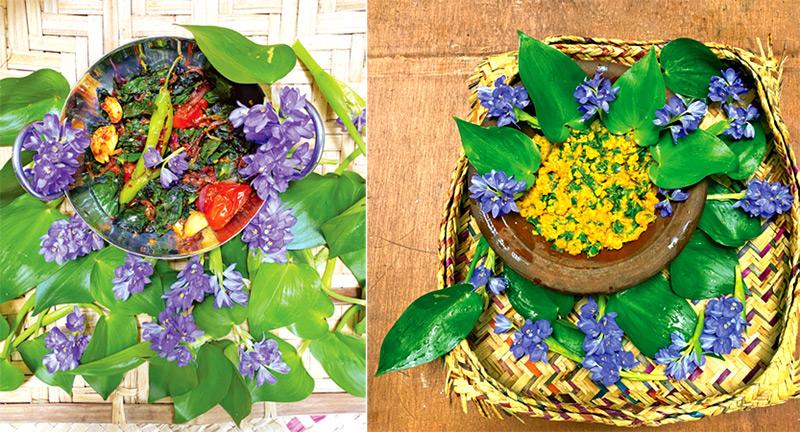
Diya Braliya which is also known as Diya Habarala is commonly regarded as an invasive weed in paddy fields. This is a semi-aquatic herbaceous plant and is scientifically known as Monochoria vaginalis. This has many English names such as oval-leafed pondweed and heartleaf false pickerelweed. The leaves are heart-shaped and the plant bears purple flowers.
This paddy weed is native to the Asian continent. Apart from paddy fields, this can also occur in swamps, marshes, ditches, drains, mudflats, and shallow-water ponds. This highly competitive plant requires a constant supply of water for better growth. This grows as an annual weed in paddy fields and is perennial in constantly watered conditions.
Since oval-leafed pondweed is highly competitive, rapidly growing and requires minimal conditions for growth despite a constant supply of water, this has become a threat to paddy cultivation. Since the plant is comparatively larger than other weeds, manual elimination is easy.
Medicinal uses
Nevertheless, habitat loss has been a threat to the existence of this plant. Unsustainable developmental activities, destruction of wetlands and marshes, excessive use of pesticides and harmful agro-chemicals have also been identified as threats to the existence of Diya Beraliya in Sri Lanka.
Diya Beraliya is used in Sri Lankan ethnomedicine mainly as detoxification, healing and cooling agent. As per ethnomedical practitioner Dr. Palitha Sri Geegana Arachchige, Diya Beraliya is the main ingredient in Nilyadi Thailaya which is used as a topical application for head.
“Diya Beraliya has an excellent cold potency. The oil prepared using Diya Beraliya is used for treating hair-related problems as well as mental illnesses. This is diuretic and is good for the kidneys. This detoxifies the liver and the kidneys, purifies blood and helps obtain clear skin. This helps control diabetes and cures constipation. Diya Beraliya reduces high blood pressure. This herb helps keep the heart in good condition, reduces body inflammation produced by excessive heat in the body. This also helps improve vision,” Dr. Geegana Arachchige said.
Food value
Since the weed has a food value, the invasive nature of the plant can be beneficial in assuring food security. The weed can well be used as a vegetable to fight food as well as nutrient insecurity and prevent malnutrition. In the past, people did not bother about the invasive nature of the plant, instead benefitted from that. Since the weed has food and ethnomedicinal value, people did not consider Diya Beraliya as a bothersome weed. They incorporated the plant in their meals as well as in ethnomedicine.
Sri Lankans have a wide range of culinary applications with this invasive weed. Villagers commonly consume tender Diya Beraliya leaves whereas, stem and flowers are edible too. Villagers prepare a curry with Diya Beraliya by adding red lentils (Parippu) or jack seeds (Kos Ata). Diya Beraliya is prepared as a salad and Melluma too. Some add Diya Beraliya leaves in herb porridge (Kola Kenda).
Although people in the past immensely benefitted from this invasive plant, the present generation is least aware of the culinary as well as medicinal uses of the plant.
Awareness should be raised in the public of the edibility of Diya Beraliya and how it can be used during a food shortage. Since this wild vegetable can be procured without any cost, it is economical too. Laden with vitamins, minerals, and anti-oxidants, Diya Beraliya is a nutritious vegetable that can fight malnutrition in children.
Curried Diya Beraliya
Although new to many people, Diya Beraliya curry is a delicacy enjoyed by our predecessors. Diya Beraliya Vanjanaya is still one of the favourite curries among villagers. Tender Diya Beraliya leaves are widely used for culinary uses while some prefer adding the stem too.
Devilled Diya Beraliya
Ingredients
Tender Diya Beraliya
leaves- 250g
Onion- 1
Crushed garlic-5 or 6 cloves
Tomato-1
Green chilli- 1
Chilli flakes one tablespoon
Coconut oil
Soy sauce
Salt
Preparation
Heat a pan and add oil. When the oil is heated, add crushed garlic and chopped onion. Sauté under medium heat until onion becomes translucent. Then add chopped tomato, green chilli, and well-washed tender Diya Beraliya leaves. Add salt and sauté until the Diya Beraliya leaves are withered in the hot oil. Then add chilli flakes and soy sauce. Mix and sauté for a couple of minutes.
Preparation of Diya Beraliya curry
Ingredients
Tender Diya Beraliya leaves -250g
Red lentils-100g
Spring onions- 5
Green chilli- 2
Garlic- 3 cloves
A small piece of cinnamon
Curry leaves
Pandan leaf
Curry powder- 1 ½ teaspoon
Chilli powder- 1 ½ teaspoon
Turmeric powder- ¼ teaspoon
First extract of coconut milk
Second extract of coconut milk
Coconut oil- 2 tablespoons
Salt
Lime juice
Preparation
Finely chop spring onions. Chop green chilli and tomatoes. Slightly crush garlic and jack seeds. Heat a clay pot and add coconut oil. When the oil is heated, add cinnamon, curry leaves, pandan leaf. Sauté for a few seconds and add chopped spring onions and crushed garlic. Sauté for two minutes. Then add chopped tomatoes and green chilli and sauté for a few minutes until the raw smell from the ingredients vanishes. Add curry powder, chilli powder and cleansed red lentils and sauté for two minutes. Add turmeric powder. Then add second extract of coconut milk and salt. Cook until the dhal become tender. Wash Diya Beraliya leaves well. Chop and add in the cooked dhal. Add the first extract of coconut milk and cook for another 5-6 minutes while stirring to prevent coconut milk from forming lumps.
Remove from heat and add lime juice and stir well.
